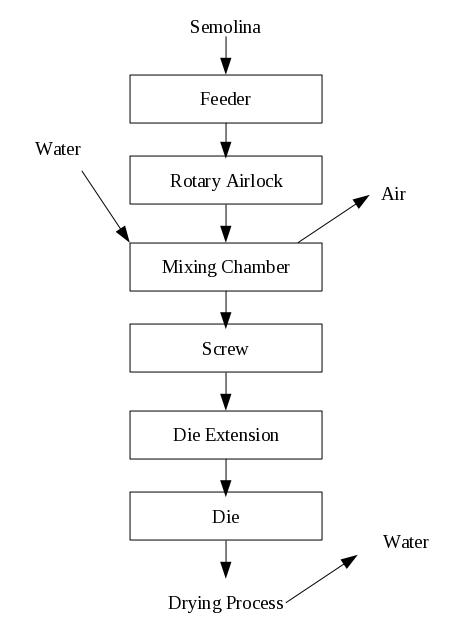Pasta Extrusion
This website is intended to deal with food extrusion processes. Therefore: this page site will not deal with sheeted pasta products.
The pasta manufacturing process very simple for ingredients and the extrusion process. Drying of pasta is not nearly as basic.
Ingredients:
Semolina. This is the part of the durum wheat kernel that is not the germ or the bran. It is a fairly large particle size and yellow or golden in color.
Water.
That's it for pasta in general. There are colored and flavored pastas, as well as nutritionally enhanced pasta, but the normal pasta you will buy at the store is semolina and water (water is removed during drying). There is some nutritional fortification, but it is at a very low level.
The first pasta presses (extruders) were piston pumps. For this process, a hydrated semolina was added to the cylinder and the piston pressed the resulting dough out of a die. It was then collected and dried. If the shape had to be cut, it was most likely cut by hand.
The basic modern process is to feed semolina
(typically about 12-14% moisture) through a rotary airlock using a loss
in wieght feeder.
The airlock is required because the semolina drops into a mixing
chamber that under vacuum. The system is under vacuum for tow
major reasons: prevent the formation of bubbles in the pasta when it
exits the die, and reduce color loss in the semolina due to
oxidation. Water is introduced to the semolina at the inlet end
of the mixing chamber. The mixing chamber mixes water with
semolina and allows time for the water to penetrate into the semolina
particles. At the outlet end of the mixing chamber is the inlet
to the extruder screw.
Typically, the extruder screw is choke fed from the
mixing chamber. The extruder screw tends to be deep flighted and
run at a very low rotational speed. The combination of deep
flights and low rotational speeds generates a minimal amount of heat in
the pasta dough. The extruder barrel is typically jacketed to
remove some of the heat generated by the rotation of the screw.
The common design of the extruder screw is to have a "compression"
section at the end of the screw to help ensure a rapid pressure
increase before the exit of the screw.
At the end of the extruder, it is not unusual to find a
breaker plate. This is a resistance to flow the forces the dough
to flow through relatively small openings. In large pasta lines,
the path to the die tends to have a long residence time, essentially
having a die extension simply through the practical design of the
die. On small extruders, such as pilot-scale systems or benchtop
systems, it is not unusual to see an extension added. This
extension gives additional time for the dough, under eleveated pressure
and having experienced some shear, to have the moisture content of the
dough equilibrate. This helps prevent white spots or streaks from
the interior of semolina that has not been completely hydrated.
At the end of the die extension, there is a 90 degree turn, taking the
flow from being horizontal to being vertical as the dough feeds into
the die. The pasta dough exits the die at about 31% moisture.
The die is oriented with the outlet facing
downward. The die gives a 2-dimensional shape to the pasta.
That shape can be a simple circle (spaghetti), a tube, star, or about
any shape that can be imagined. Pasta has flow characteristics
that allow a significant amount of 3-dimensional shape. Rotini,
for example, rotates as it exits the die. For short goods, a
knife cuts the shape to the desired length. Long goods
(spaghetti, linguini, etc) are spread over bars to a length of double
or more the length of the product in the box. There is commonly
air blowing at the die face to give some initial surface drying of the
product. The "dried" surface helps prevent product from sticking
togther when 2 pieces of pasta touch.
Product is conveyed into the dryer and dried.
Pasta needs to be dried slowly to prevent checking (cracks that form in
the pasta due to stress created during drying). A high
temperature drying system may be able to dry short goods or thin long
goods in about 2 hours, with most long goods or thick short goods
requiring up to about 5 hours. Traditional drying systems can
take 24 hours or more to dry pasta.
